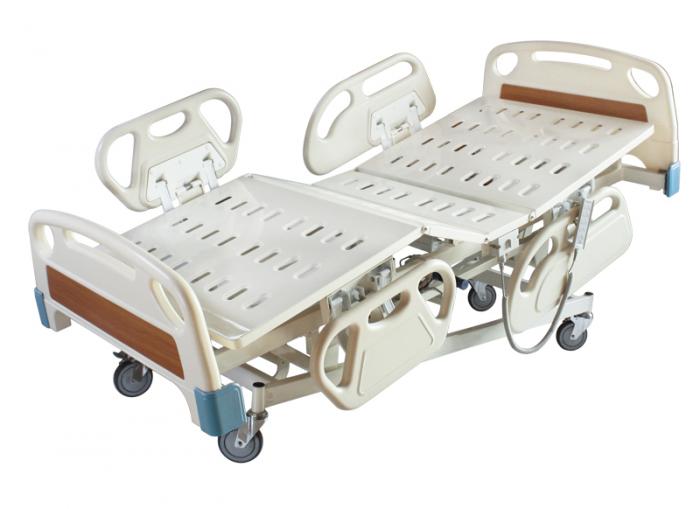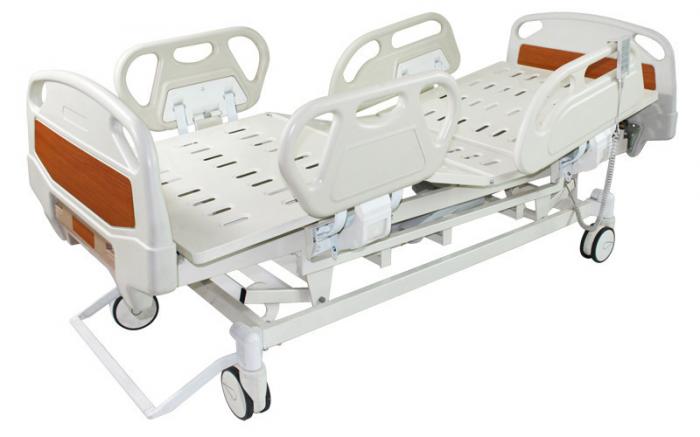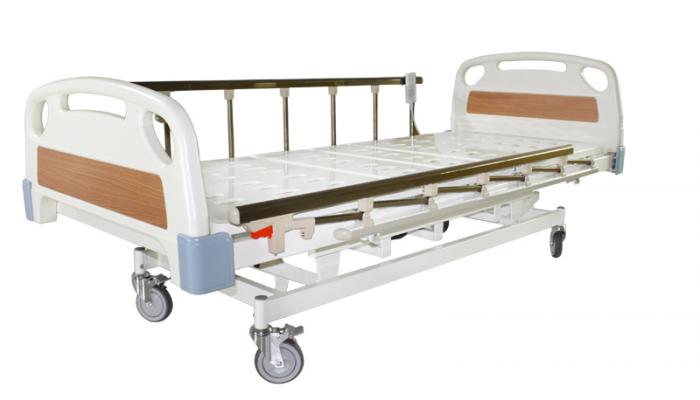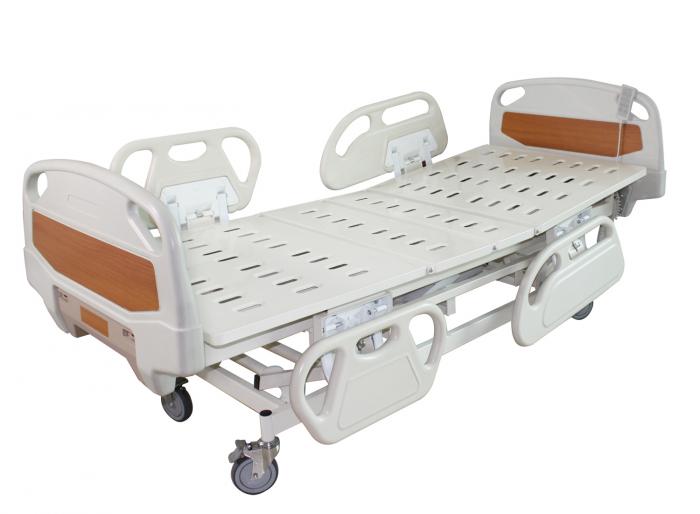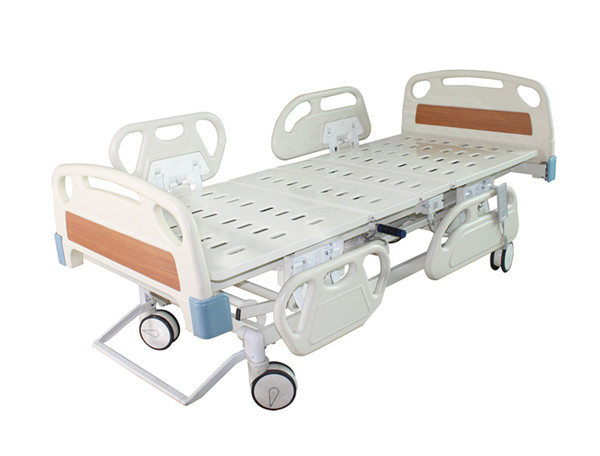| Name: | Electric Hospital Beds |
|---|---|
| Model No.: | BES-HB009 |
| Material: | Steel Frame |
| Brand: | BESCO |
| Product Name: | Electric Hospital beds |
| LEAD TIME: | 30 days |
| Weight Capacity: | 220 kgs |
| MOQ: | 15 units |
| Sample: | Available |
| Payment Term: | T/T in advance |
| Country of Original: | China |
| Stock: | Available |
| Port: | Jiangmen |
| Office: | Zhengzhou,China |
Products Description
Five-function Electric Hospital Beds
Function:
Back-rest tilting is 0~60º.
Knee-rest tilting is 0~45º.
Height adjustment is 450 ~760mm.
Trendelenburg and reverse trendelenburg are 12º.
Standard accessory:
PE plastic side rails.5" castors four motors system.
Optional:
Two sectional IV pole,mattress,Over bed table,central lock system,CPR function,backup battery
| Dimension | L2180*W960*H450~760mm |
| Material | Steel framework |
| Backrest adjustment angle | 0-60º |
| Leg rest adjustment angle | 0-45º |
| Height adjustment range | 450~760 mm |
| Trendelenburg and reverse trendelenburg angle | 12º/12º |
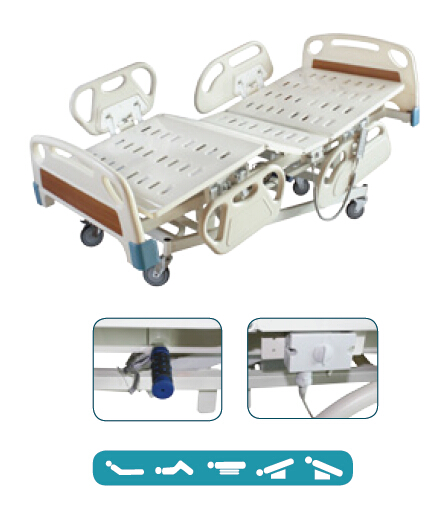
The economy of Electric hospital beds involves several key functions that impact healthcare delivery and resource management.
1. Patient Care Capacity
Hospital beds serve as the primary resource for patient care, determining how many patients can be treated simultaneously. This capacity directly affects hospital efficiency and patient outcomes.
2. Resource Allocation
Effective management of hospital beds ensures optimal use of resources, including staff, equipment, and facilities. This involves balancing bed availability with patient admissions and discharges.
3. Financial Management
Hospital beds represent a significant financial investment. Their management influences operational costs, revenue generation, and overall financial health of the institution.
4. Quality of Care
The availability and condition of hospital beds impact the quality of care provided. Overcrowding can lead to increased wait times and reduced patient satisfaction.
5. Strategic Planning
Data on bed utilization informs strategic decisions regarding expansions, renovations, and service offerings. Hospitals analyze trends to anticipate future needs and improve service delivery.
These functions highlight the importance of effective hospital bed management in maintaining a sustainable healthcare system.
5-function Economy Electric hospital beds refer to a hospital bed that offers five adjustable features: typically, these include adjustments for the head (backrest), foot (leg rest), overall bed height, Trendelenburg position, and reverse Trendelenburg position. These adjustments allow for customized patient positioning and enhanced comfort and are controlled by an electric motor.
Here's a more detailed breakdown:
Head (Backrest) Adjustment:
.The backrest can be raised or lowered to facilitate various activities like sitting up for meals or medical procedures.
Foot (Leg Rest) Adjustment:
.The leg rest can be adjusted to elevate the feet and legs, which can be helpful for circulation or comfort.
Height Adjustment:
.The entire bed can be raised or lowered, which aids in patient transfer and caregiver access.
Trendelenburg Position:
.The bed can be tilted so that the patient's head is lower than their feet.
Reverse Trendelenburg Position:
.The bed can be tilted so that the patient's feet are lower than their head.
An electric hospital bed is a healthcare bed that uses electric motors and a handheld remote to adjust the patient's position and the bed's overall height, providing enhanced comfort, improved patient care, and easier caregiver access compared to traditional beds. These beds offer features like motorized adjustment for the head and foot sections, customizable height, safety features such as side rails, and durable construction for continuous patient use.
Key Features
Motorized Adjustments:
Electric motors allow for effortless, precise adjustments to the bed's height, backrest, and leg sections, which can be controlled by a remote pendant.
Convenient Remote Control:
A hand pendant with large buttons provides easy control for both patients and caregivers to find optimal positions.
Adjustable Height:
The bed's height can be raised or lowered with ease, which is beneficial for patient transfers and caregiver access.
Safety Features:
Many electric hospital beds include side rails to prevent falls, recessed components to avoid pinch points, and sometimes a manual crank for use during power outages.
Durable Construction:
They are built with heavy-duty frames and durable panels for long-term use in hospitals and home care settings.
Mobility:
Most beds are equipped with casters for easy movement, often with locking mechanisms for secure positioning.
Benefits
For Patients:
Enhanced comfort through customizable positioning, reduction in pressure points, and improved sleep quality.
For Caregivers:
Reduced physical strain during adjustments and easier access to patients for care.
Versatility:
The ability to adjust the bed for various tasks, such as eating, reading, or sleeping.
Safety:
Increased safety for patients with features like side rails and reduced risk of injuries from pinch points.
